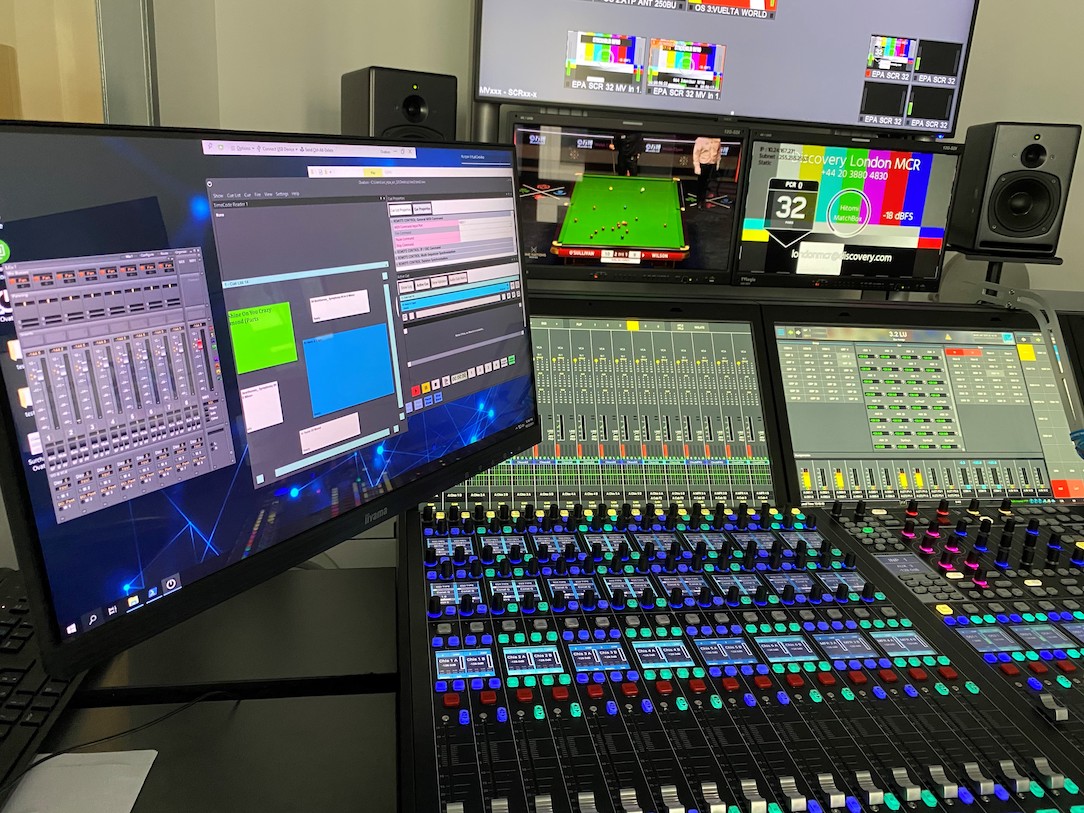The introduction of IP technology is having a profound impact on how major events are managed and provides opportunities for significant improvements in efficiency with a reduction in hardware needing to be shipped to the venue. This programme of change was ongoing before Covid-19 added to the momentum. Initially, with major sporting events all being cancelled, it might be assumed that the rate of change would have slowed. The need for social distancing at all stages of the broadcast chain further emphasised the need to reduce the crew travelling to the event, but still provide the capacity for local commentaries and programming. The recent Grand Slam tennis events in New York and Paris saw the Eurosport Cube introduced, accompanied by some major changes in the technical solutions employed. One of these was addition of auto-mixing from LAMA (Lean And Mean Audio) working with Virtual Machines which requires an ASIO driver that can synchronise all audio machines with low latency. This system depends on additional hardware and some software from Merging Technologies.
The demands of these major events need to be understood to make sense of why moving to this workflow not only makes sense but is essential. The sheer size and complexity need to be understood. A major driver is the need to cater for more commentators without purchasing more hardware. The first request was to produce 45 concurrent feeds during the Olympics in 21 languages, so almost 1,000 mixes are required for programme mixes for Discovery and Eurosport’s digital platform (Eurosport Player). By contrast, the week after the Olympics the daily requirement might return to only 60 different mixes. Being able to define exactly what was needed and deliver this quickly through software is crucial. Flexibility and scalability are the two key words prevailing.
The Olympics and many other major sports events were either cancelled or postponed early in 2020, but there are similar temporary peaks in demand for tennis tournaments like the recent US and French Open Tennis. With the traditional hardware setup, Eurosport would have been faced with an extra challenge when commentators had to work remotely due to Covid. Working with a software solution was key in responding to this situation. The need to be able to increase capacity on demand, prompted the decision to start using virtual machines. Simply stated, VM’s are more interesting in terms of cost, because having a pool of virtual machines reduces the price. Also, one can move a VM or recreate a VM if there is a problem and you can scale VM’s for what you need tomorrow.
There are other strong drivers for broadcasters to look at similar solutions. Although there are hopes for some return to normality in 2021, nobody can be sure under what conditions. Looking to the Olympics as an example, the need for a solution with a mix minus system such as provided by the LAMA is paramount, so that commentaries and virtual crowds can be added remotely. COVID rules next August may prevent having several commentators in one booth. Meaning that if you have 300 mixes with 2 commentators, who have to be in different booths, that would be 600 booths which is impractical and too expensive. It is also possible to control more mixes with just one operator. This is a logical development and not just because of medical advice; it is clearly a natural progression to increase efficiency without compromising the viewer experience that is driving broadcasters as technology permits. The key is to provide more mixes without adding more operators.
Many broadcasters are now delivering content on digital platforms, with a selection of different events available continuously. There are also moves within the industry to improve the user experience. This is not just introducing immersive audio and new accessibility solutions, there is now a requirement to offer user selectable options. With sports, there is already a move to have more commentaries in one language. For example, with a football match you can have one commentary from the perspective of one team and another from the opposing team or just audio from the pitch without the commentary. So, if you imagine there 45 events with all these languages, multiplied by the number of different options for commentaries, it then becomes essential to move to these types of self-running solutions.
Eurosport has invested in Hapi and Horus networked audio converters that were ST2110-30 compliant. There are now over 20 Hapi units deployed with a handful of the larger Horus units. More recently, MERGING+ANUBIS units are being added as are an increasing number of Ovation Media Servers. The AETA ScoopTeam commentary units also share the Merging ZMAN technology that is a central component of Anubis. This ensures that AES67 compatibility is guaranteed between these essential hardware devices. What became clear was that some additional custom features would be required to realise the full potential of the system. ANEMAN Enterprise was tailored to suit the much larger facility but it was also necessary to develop an ASIO driver capable of working with Virtual Machines. This driver technology is now employed in two Tech-Hubs located in the UK and the Netherlands with 36 VMs in each location with plans for future expansion. The Merging units provide the ASIO clock derived from the PTP Grand Master and the audio VMs are running applications such as LAMA or Merging’s Ovation Media Server.
Merging recently introduced the Anubis SPS to add ST2022-7 to the NMOS and ST2110-30 capability shared by all Merging interfaces. These protocols are also provided by the new Merging Audio Device (MAD) when the Infrastructure Pack is added. Not only does this provide multi-ASIO capability but it also adds WDM (Windows Driver Model) to the range of options to combine different media feeds.
Claude Cellier, (Merging’s President and CEO) summarised the company’s outlook: “We have invested considerable time to ensure we kept abreast of the fast-moving developments of the IP world. It is really stimulating to work with companies who are pushing the boundaries and Eurosport is clearly doing this. This not only results in products that perform a function, it leads us to contribute key parts of systems that offer real benefits in cost and efficiency, resulting in a better viewer experience. Working in partnership with LAMA, we feel that the success of Roland-Garros demonstrated that particularly well. We are not done yet; there will be more products coming soon to improve the workflow and integrate more easily into the total IP infrastructure.”






